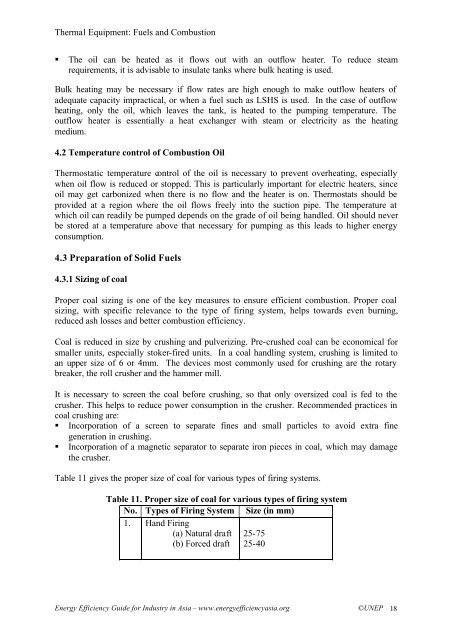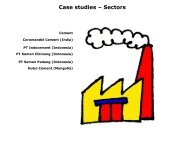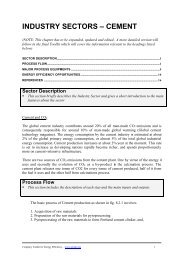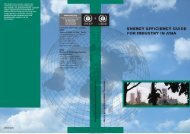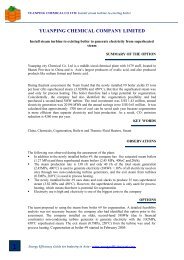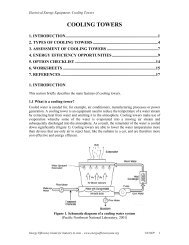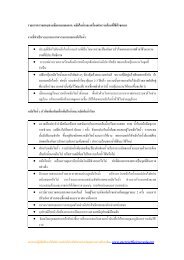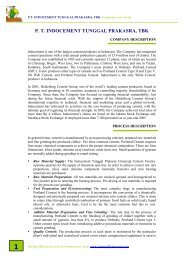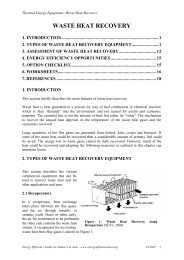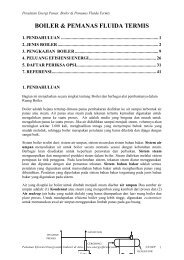Chapter - Fuels and Combustion - RETScreen International
Chapter - Fuels and Combustion - RETScreen International
Chapter - Fuels and Combustion - RETScreen International
You also want an ePaper? Increase the reach of your titles
YUMPU automatically turns print PDFs into web optimized ePapers that Google loves.
Thermal Equipment: <strong>Fuels</strong> <strong>and</strong> <strong>Combustion</strong><br />
• The oil can be heated as it flows out with an outflow heater. To reduce steam<br />
requirements, it is advisable to insulate tanks where bulk heating is used.<br />
Bulk heating may be necessary if flow rates are high enough to make outflow heaters of<br />
adequate capacity impractical, or when a fuel such as LSHS is used. In the case of outflow<br />
heating, only the oil, which leaves the tank, is heated to the pumping temperature. The<br />
outflow heater is essentially a heat exchanger with steam or electricity as the heating<br />
medium.<br />
4.2 Temperature control of <strong>Combustion</strong> Oil<br />
Thermostatic temperature control of the oil is necessary to prevent overheating, especially<br />
when oil flow is reduced or stopped. This is particularly important for electric heaters, since<br />
oil may get carbonized when there is no flow <strong>and</strong> the heater is on. Thermostats should be<br />
provided at a region where the oil flows freely into the suction pipe. The temperature at<br />
which oil can readily be pumped depends on the grade of oil being h<strong>and</strong>led. Oil should never<br />
be stored at a temperature above that necessary for pumping as this leads to higher energy<br />
consumption.<br />
4.3 Preparation of Solid <strong>Fuels</strong><br />
4.3.1 Sizing of coal<br />
Proper coal sizing is one of the key measures to ensure efficient combustion. Proper coal<br />
sizing, with specific relevance to the type of firing system, helps towards even burning,<br />
reduced ash losses <strong>and</strong> better combustion efficiency.<br />
Coal is reduced in size by crushing <strong>and</strong> pulverizing. Pre-crushed coal can be economical for<br />
smaller units, especially stoker-fired units. In a coal h<strong>and</strong>ling system, crushing is limited to<br />
an upper size of 6 or 4mm. The devices most commonly used for crushing are the rotary<br />
breaker, the roll crusher <strong>and</strong> the hammer mill.<br />
It is necessary to screen the coal before crushing, so that only oversized coal is fed to the<br />
crusher. This helps to reduce power consumption in the crusher. Recommended practices in<br />
coal crushing are:<br />
• Incorporation of a screen to separate fines <strong>and</strong> small particles to avoid extra fine<br />
generation in crushing.<br />
• Incorporation of a magnetic separator to separate iron pieces in coal, which may damage<br />
the crusher.<br />
Table 11 gives the proper size of coal for various types of firing systems.<br />
Table 11. Proper size of coal for various types of firing system<br />
No. Types of Firing System Size (in mm)<br />
1. H<strong>and</strong> Firing<br />
(a) Natural draft 25-75<br />
(b) Forced draft 25-40<br />
Energy Efficiency Guide for Industry in Asia – www.energyefficiencyasia.org ©UNEP 18


